Geochemical Studies of Detrital Zircon Grains from the River Banks and Beach Placers of Coastal Odisha, India
Abstract
1. Introduction
2. Geology of the Study Area
3. Field Survey and Sample Preparation
4. Experimental Methodology
5. Results and Discussion
5.1. Radiometric Survey
5.2. Trace Elements and REE Geochemistry
5.3. Textural Analysis of Zircons
6. Discussion
7. Conclusions
- The present study, undertaken for the first time, was useful in delineating the geochemical nature of zircon grains from beach placers and river banks of eastern India, in terms of their trace element variations. The abundance of specific trace elements and their radionuclide content is important for the evaluation of their resource potential for industrial-grade applications, both indigenously as well as in terms of their export potential. This would also be useful in terms of value addition, especially for zirconium, to meet the energy requirements of the country based on nuclear power.
- The zircons studied exhibited a trace element variation in the following descending order: Hf (mean = 11,270 ppm) > Y (mean = 1064 ppm) > P (mean = 455 ppm) > U (mean = 430.77 ppm) > Th (mean = 220 ppm).
- The low Th/U ratio in the zircons studied suggested a metamorphic origin due to high-grade metamorphism in the Eastern Ghats Mobile Belt.
- The metamorphic zircons showed characteristics quite similar to magmatic zircons, as indicated by the high Y, Hf and P content, and a steep REE pattern, positive Ce anomaly and negative Eu anomaly. This could be attributed to the ultrahigh-temperature metamorphism experienced during the formation of zircons from the partial melt that occurred in the metamorphic neosome.
Author Contributions
Funding
Data Availability Statement
Acknowledgments
Conflicts of Interest
References
- Hoskin, P.W.O.; Ireland, T.R. Rare earth element chemistry of zircon and its use as a provenance indicator. Geology 2000, 28, 627–630. [Google Scholar] [CrossRef]
- Rubatto, D. Zircon trace element geochemistry: Partitioning with garnet and the link between U–Pb ages and metamorphism. Chem. Geol. 2002, 184, 123–138. [Google Scholar] [CrossRef]
- Balaram, V. Rare earth elements: A review of applications, occurance, exploration, analysis, recycling, and environmental impact. Geosci. Front. 2019, 10, 1285–1303. [Google Scholar] [CrossRef]
- Gun No, S.; Park, M.E. The geochronology and Geochemistry of zircons as Evidence for the Reconcentration of REE in the Triassic Period in the Chungju Area, South Korea. Minerals 2020, 10, 49. [Google Scholar] [CrossRef]
- Khan, R.; Mohanty, S.; Sengupta, D. Elemental distribution in core sediments of Podampata coast, eastern Odisha, India: Potentiality of rare earth elements and Th exploration. Arab. J. Geosci. 2021, 14, 81. [Google Scholar] [CrossRef]
- Ghosal, S.; Agrahari, S.; Banerjee, D.; Sengupta, D. Assessment of a naturally occurring high background radiation area with elevated levels of thorium along coastal Odisha, India using radiometric methods. Chemosphere 2021, 283, 131–221. [Google Scholar] [CrossRef] [PubMed]
- Mohanty, S.; Adak, S.; Sengupta, D. Granulometric analysis of beach sediments enriched in radioactivity along Podampata, east coast of Odisha, India. J. Earth Syst. 2021, 130, 108. [Google Scholar] [CrossRef]
- Charalampides, G.; Vatalis, K.I.; Apostoplos, B.; Ploutarch-Nikolas, B. Rare Earth Elements: Industrial Applications and Economic Dependency of Europe. International Conference on Applied Economics (ICOAE). Procedia Econ. Financ. 2015, 24, 126–135. [Google Scholar] [CrossRef]
- USGS Mineral Resources Program. The Rare-Earth Elements—Vital to Modern Technologies and Lifestyles; Report 2014-3078; U.S. Department of the Interior: Washington, DC, USA, 2014; ISSN 2327-6932. [CrossRef]
- John, E. Nature’s Building Blocks: An A-Z Guide to the Elements, 2nd ed.; Oxford University Press: New York, NY, USA, 2011. [Google Scholar]
- Government of India. Zircon. In Indian Mineral Year Book, 59th ed.; Mineral Review; Government of India: New Delhi, India, 2000. [Google Scholar]
- Sengupta, D.; Van Gosen, B.S. Placer-type rare earth element deposits. Rare earth and critical elements in ore deposits. Rev. Econ. Geol. 2016, 18, 81–100. [Google Scholar]
- Papadopoulos, A.; Christofides, G.; Koroneos, A.; Stoulos, S. Natural radioactivity distribution and gamma radiation exposure of beach sands from Sithonia Peninsula. Cent. Eur. J. Geosci 2014, 6, 229–242. [Google Scholar] [CrossRef]
- Biswal, T.K.; Sinha, S. Deformation history of the NW salient of the Eastern Ghats Mobile Belt, India. J. Asian Earth Sci. 2003, 22, 157–169. [Google Scholar] [CrossRef]
- Mukhopadhyay, D.; Basak, K. The Eastern Ghats Belt-A Polycyclic Granulite Terrain. J. Geol. Soc. India 2009, 73, 489–518. [Google Scholar] [CrossRef]
- Ramkrishnan, M.J. Geological evolution of the Proterozoic Eastern Ghats Mobile Belt. Geol. Surv. India Spec. Publ. 1998, 44, 1–21. [Google Scholar]
- Petrelli, M.; Perugini, D.; Alagna, K.E.; Poli, G.; Peccerillo, A. Spatially resolved and bulk trace element analysis by laser ablation-inductively coupled plasma –mass spectrometry (LA–ICP–MS). Period. Mineral. 2008, 77, 3. [Google Scholar]
- Belousova, E.; Griffin, W.; O'Reilly, S.Y.; Fisher, N. Igneous zircon: Trace element composition as an indicator of source rock type. Contrib. Mineral. Petrol. 2002, 143, 602–622. [Google Scholar] [CrossRef]
- Rubatto, D.; Williams, I.S.; Buick, I.S. Zircon and monazite response to prograde metamorphism in the Reynolds Range, central Australia. Contrib. Mineral. Petrol. 2001, 140, 458–468. [Google Scholar] [CrossRef]
- Grimes, C.B.; John, B.E.; Kelemen, P.B.; Mazdab, F.K.; Wooden, J.L.; Cheadle, M.J.; Hanghøj, K.; Schwartz, J.J. Trace element contents in zircons from oceanic crust: A method for distinguishing detrital zircon provenance. Geology 2007, 35, 643–646. [Google Scholar] [CrossRef]
- Angusami, N.; Loveson, V.J.; Rajamanickam, G.V. Zircon and ilmenite from the beach placers of southern coast of Tamilnadu, east coast of India. Indian J. Mar. Sci. 2004, 33, 138–149. [Google Scholar]
- Rozendaal, A.; Philander, C.; de Meijer, R.J. Mineralogy of Heavy Mineral Placers along the West Coast of South Africa. In Heavy Minerals Conference 1999; Stimson, R.G., Ed.; South African Institute of Mining and Metallurgy: Johannesburg, South Africa, 1999; pp. 67–73. [Google Scholar]
- Yang, W.; Lin, Y.; Hao, J.; Zhang, J.; ·Hu, S.; ·Ni, H. Phosphorus-controlled trace element distribution in zircon revealed by NanoSIMS. Contrib. Mineral. Petrol. 2016, 171, 28. [Google Scholar] [CrossRef]
- Elinson, S.V.; Petrov, K.L. Analytical Chemistry of Zirconium and Hafnium: Ann Arbor, Ann Arbor-Humphrey Science; Ann Arbor-Humphrey Science Publishers: Ann Arbor, MI, USA, 1969; 243p. [Google Scholar]
- Owen, M.R. Hafnium content of detrital zircons, a new tool for provenance study. J. Sediment. Petrol. 1987, 57, 824–830. [Google Scholar]
- Sheikh, L.; Lutfi, W.; Zhidan, Z.; Awais, M. Geochronology, trace elements and Hf isotopic geochemistry of zircons from Swat orthogneisses, Northern Pakistan. Open Geosci. 2020, 12, 148–162. [Google Scholar] [CrossRef]
- Rudnick, R.L.; Gao, S. Composition of the continental crust. Treatise Geochem. 2014, 4, 1–64. [Google Scholar]
- Papadopoulos, A.; Christofides, G.; Koroneos, A.; Poli, G. Concentration of 238U and 232Th among constituent minerals of two igneous plutonic rocks exhibiting elevated natural radioactivity levels. J. Radioanal. Nucl. Chem. 2013, 298, 639–650. [Google Scholar] [CrossRef]
- Yakymchuk, C.; Kirkland, C.L.; Clark, C. Th/U ratios in metamorphic zircon. J. Metamorph. Geol. 2018, 36, 715–737. [Google Scholar] [CrossRef]
- Sun, S.S.; McDonough, W.F. Chemical and isotopic systematics of oceanic basalts: Implications for mantle composition and processes. Geol. Soc. Lond. Spec. Publ. 1989, 42, 313–345. [Google Scholar] [CrossRef]
- Hoskin, P.W.O.; Black, L.P. Metamorphic zircon formation by solid-state recrystallization of protolith igneous zircon. J. Metamorph. Geol. 2002, 18, 423–439. [Google Scholar] [CrossRef]
- Hoskin, P.W.O.; Schaltegger, U. The composition of zircon and igneous and metamorphic petrogenesis. Zircon 2003, 53, 27–62. [Google Scholar]
- Vijay Kumar, K.; Ernst, W.G.; Leelanandam, C.; Wooden, J.L. SHRIMP U-Pb ages of zircons from mafic granulites of the Eastern Ghats Belt, SE India: Implications for the evolution of the palaeoproterozoic arc crust. J. Asian Earth Sci. 2019, 177, 198–219. [Google Scholar] [CrossRef]
- Vetrina, V.R.; Skublovb, S.G. Trace Elements in Various Genetic Types of Zircon from Syenite of the Sakharjok Massif, Kola Peninsula. Geol. Ore Depos. 2016, 58, 542–550. [Google Scholar] [CrossRef]
- Oladeni, I.A. Rare-Earth Element Occurrences in Heavy Mineral Sand, Southeast Georgia. Master Thesis, Georgia State University, Atlanta, GA, USA, 2022. [Google Scholar] [CrossRef]
- Tapia-Fernandez, H.J.; Armstrong-Altrin, J.S.; Selvaraj, K. Geochemistry and U-Pb geochronology of detrital zircons in the Brujas beach sands, Campeche, Southwestern Gulf of Mexico, Mexico. J. S. Am. Earth Sci. 2017, 76, 346–361. [Google Scholar] [CrossRef]
- Armstrong-Altrin, J.S. Detrital zircon U–Pb geochronology and geochemistry of the Riachuelos and Palma Sola beach sediments, Veracruz State, Gulf of Mexico: A new insight on palaeoenvironment. J. Palaeogeogr. 2020, 9, 28. [Google Scholar] [CrossRef]
- Mehedi Hasan, A.S.M.; Hossain, I.; Aminur, R.M.; Nazim, Z.M.; Biswas, P.K.; Sha, A.M. Chemistry and mineralogy of Zr-and Ti-rich minerals sourced from Cox’s Bazar beach placer deposits, Bangladesh: Implication of resources processing and evaluation. Ore Geol. Rev. 2022, 141, 104687. [Google Scholar] [CrossRef]
- Harley, S.L.; Kelly, N.M.; Moller, A. Zircon behaviour and the thermal histories of mountain chains. Elements 2007, 3, 25–30. [Google Scholar] [CrossRef]
- Kelly, N.M.; Harley, S.L. An integrated microtextural and chemical approach to zircon geochronology: Refining the Archaean history of the Napier Complex, east Antarctica. Contrib. Mineral. Petrol. 2005, 149, 57–84. [Google Scholar] [CrossRef]
- Kelsey, D.E.; Hand, M. On ultrahigh temperature crustal metamorphism: Phase equilibria, trace element thermometry, bulk composition, heat sources, timescales and tectonic settings. Geosci. Front. 2015, 6, 311–356. [Google Scholar] [CrossRef]
- Rubatto, D. Zircon: The metamorphic mineral. Rev. Mineral. Geochem. 2017, 83, 261–295. [Google Scholar] [CrossRef]
- Vavra, G.; Schmid, R.; Gebauer, D. Internal morphology, habit and U-Th-Pb microanalysis of amphibolite-to-granulite facies zircons: Geochronology of the Ivrea Zone (Southern Alps). Contrib. Mineral. Petrol. 1999, 134, 380–404. [Google Scholar] [CrossRef]
- Bose, S.; Dunkley, D.J.; Dasgupta, S.; Das, K.; Arima, M. India-Antarctica-Australia-Laurentia connection in the Paleoproterozoic–Mesoproterozoic revisited: Evidence from new zircon U-Pb and monazite chemical age data from the Eastern Ghats Belt, India. Geol. Soc. Am. Bull. 2011, 123, 2031–2049. [Google Scholar] [CrossRef]
- Mezger, K.; Cosca, M.A. The thermal history of the Eastern Ghats Belt (India), as revealed by U-Pb and 40Ar-34Ar dating of metamorphic and magmatic minerals: Implications for the SWEAT correlation. Precambrian Res. 1999, 94, 251–271. [Google Scholar] [CrossRef]
- Upadhyay, D.; Gerdes, A.; Raith, M.M. Unraveling sedimentary provenance and tectonothermal history of high to ultra-high temperature metapelites using zircon and monazite chemistry: A case study from the Eastern Ghats Belt, India. J. Geol. 2009, 117, 665–683. [Google Scholar] [CrossRef]
- Bastia, F.; Equeenuddin, S.M.; Roy, P.D.; Hernández-Mendiola, E. Geochemical signatures of surface sediments from the Mahanadi river basin (India): Chemical weathering, provenance, and tectonic settings. Geol. J. 2019, 55, 5294–5307. [Google Scholar] [CrossRef]
- Hinton, R.W.; Upton, B.G.J. The chemistry of zircon: Variations within and between large crystals from syenite and alkali basalt xenoliths. Geochim. Cosmochim. Acta 1991, 55, 3287–3302. [Google Scholar] [CrossRef]
- Maas, R.; Kinny, P.D.; Williams, I.S.; Froude, D.O.; Compston, W. The Earth’s oldest known crust: A geochronological and geo- chemical study of 3900±4200 Ma old detrital zircons from Mt. Narryer and Jack Hills, Western Australia. Geochim. Cosmochim. Acta 1992, 56, 1281–1300. [Google Scholar] [CrossRef]
- Schaltegger, U.; Fanning, M.; Günther, D.; Maurin, J.C.; Schulmann, K.; Gebauer, D. Growth, annealing and recrystallization of zircon and preservation of monazite in high-grade metamorphism: Conventional and in-situ U–Pb isotope, cathodoluminescence and microchemical evidence. Contrib. Mineral. Petrol. 1999, 134, 186–201. [Google Scholar] [CrossRef]
- Murali, A.V.; Parthasarathy, R.; Mahadevan, T.M.; Sankar, D.M. Trace element characteristics, REE patterns and partition coefficients of zircons from different geological environments—A case study on Indian zircons. Geochim. Cosmochim. Acta 1983, 47, 2047–2052. [Google Scholar] [CrossRef]

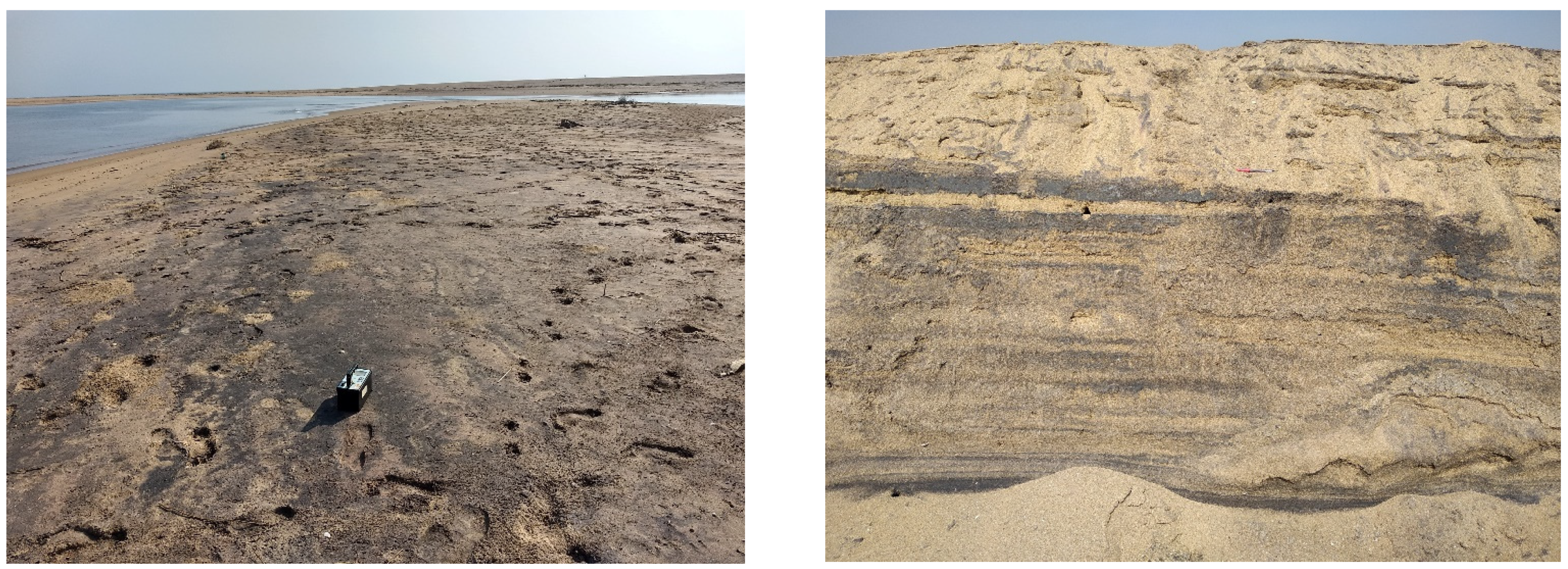
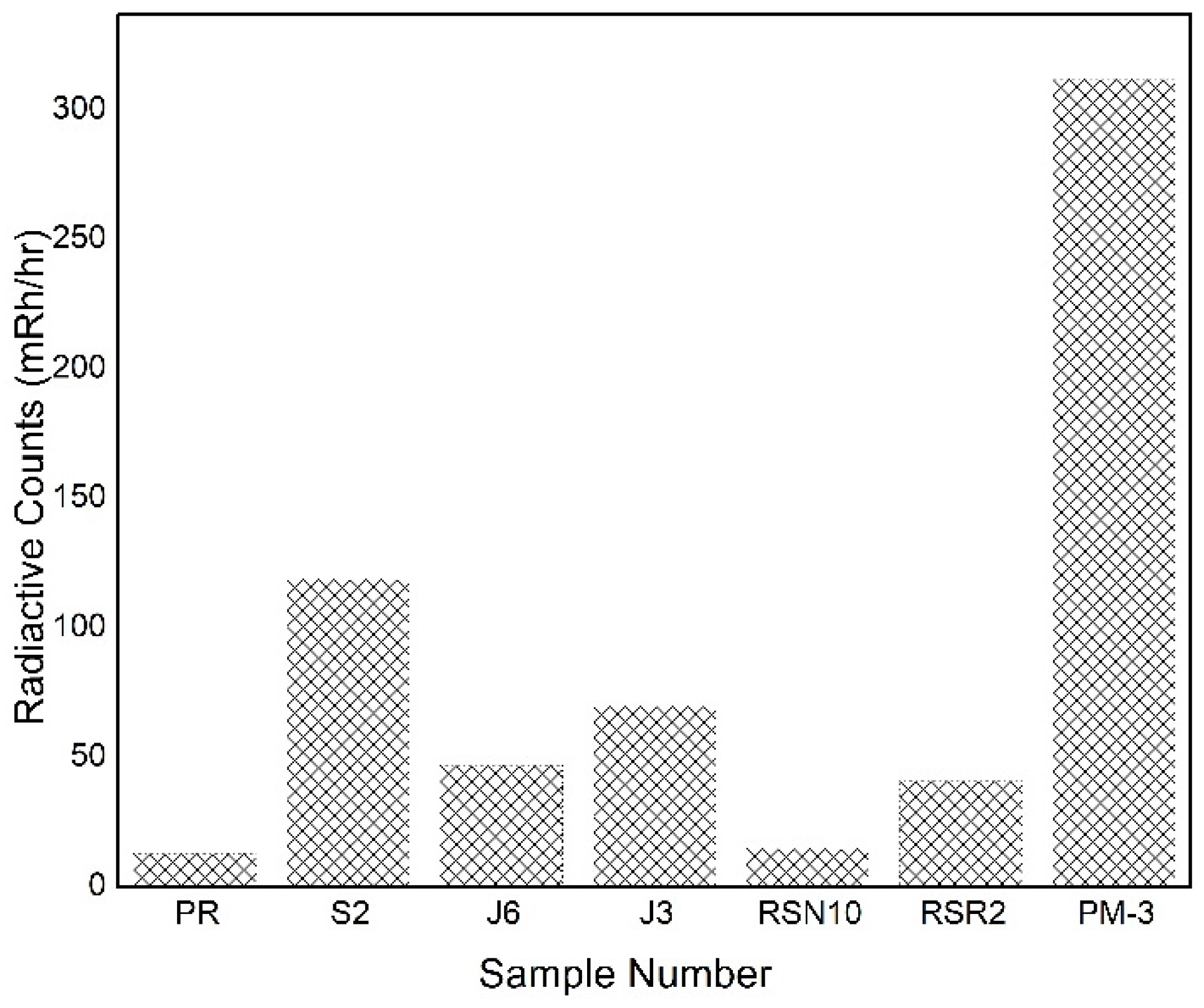
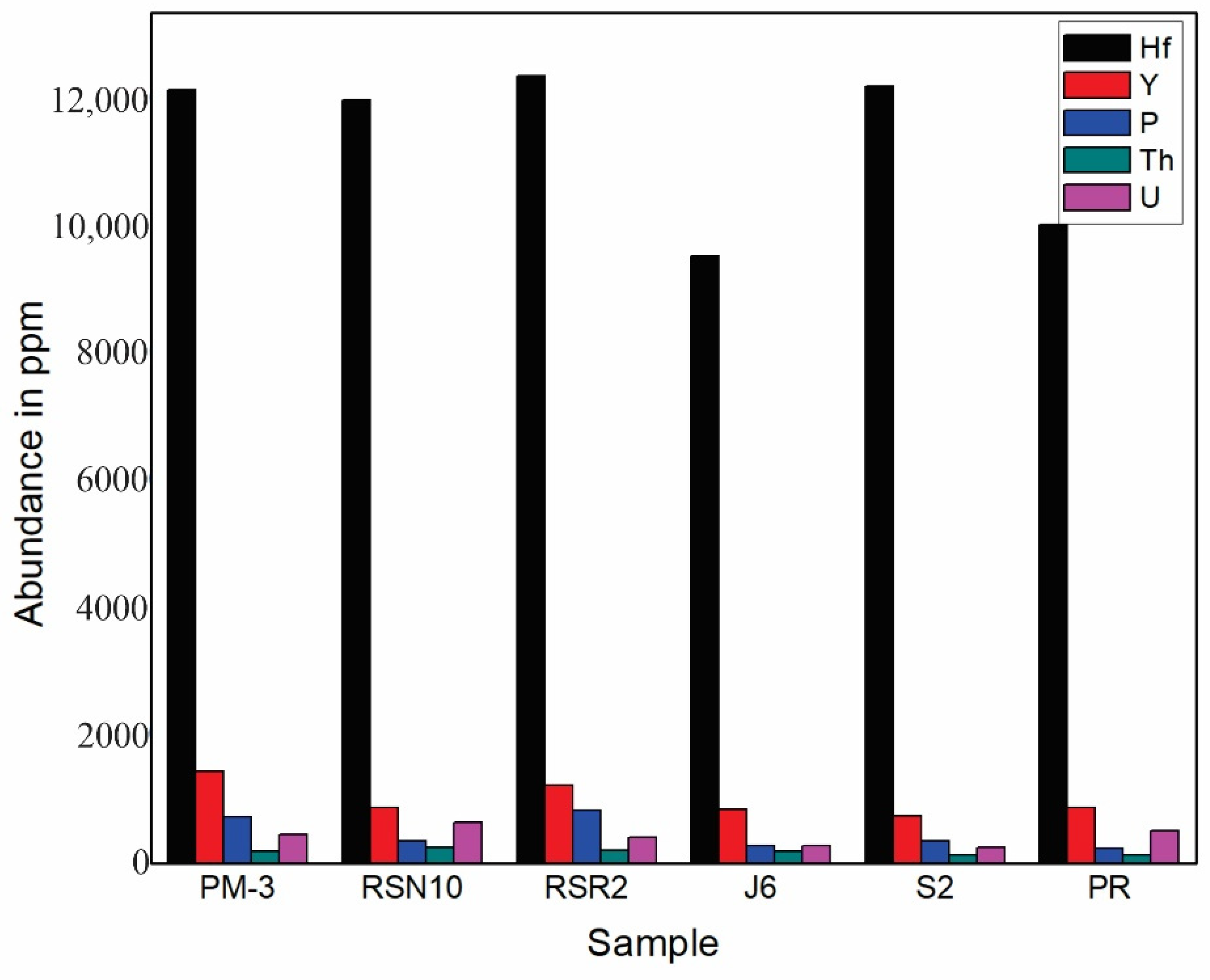

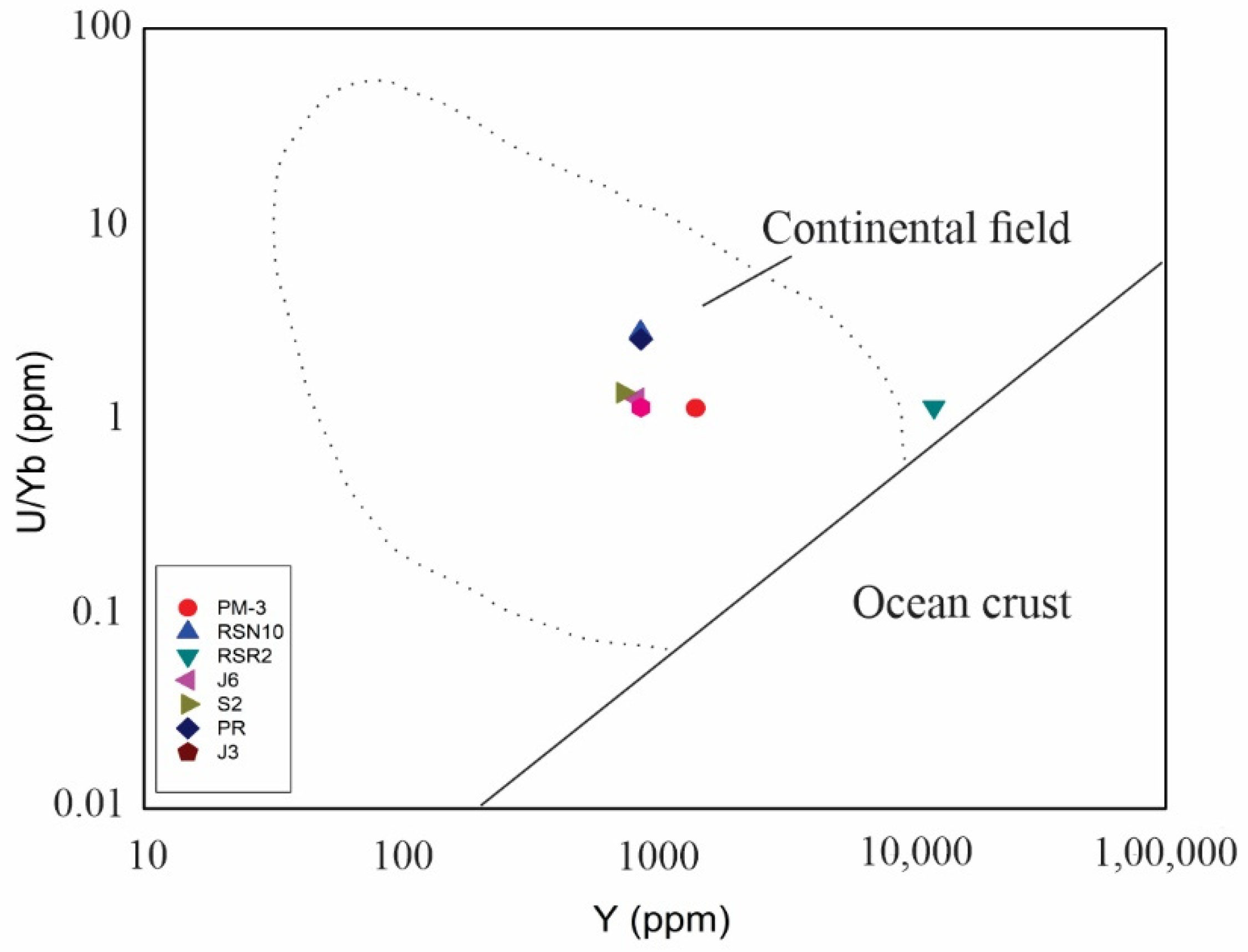
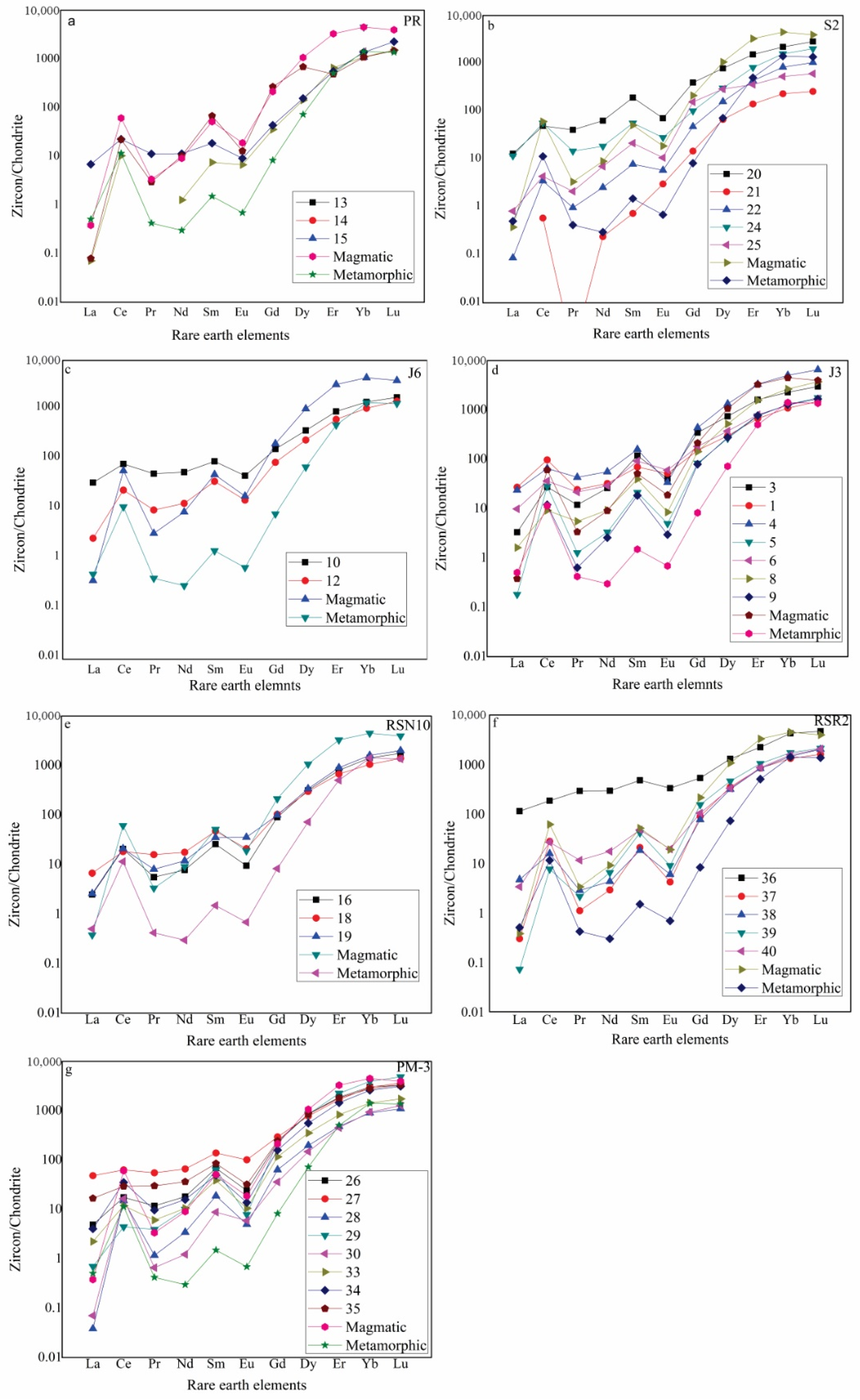
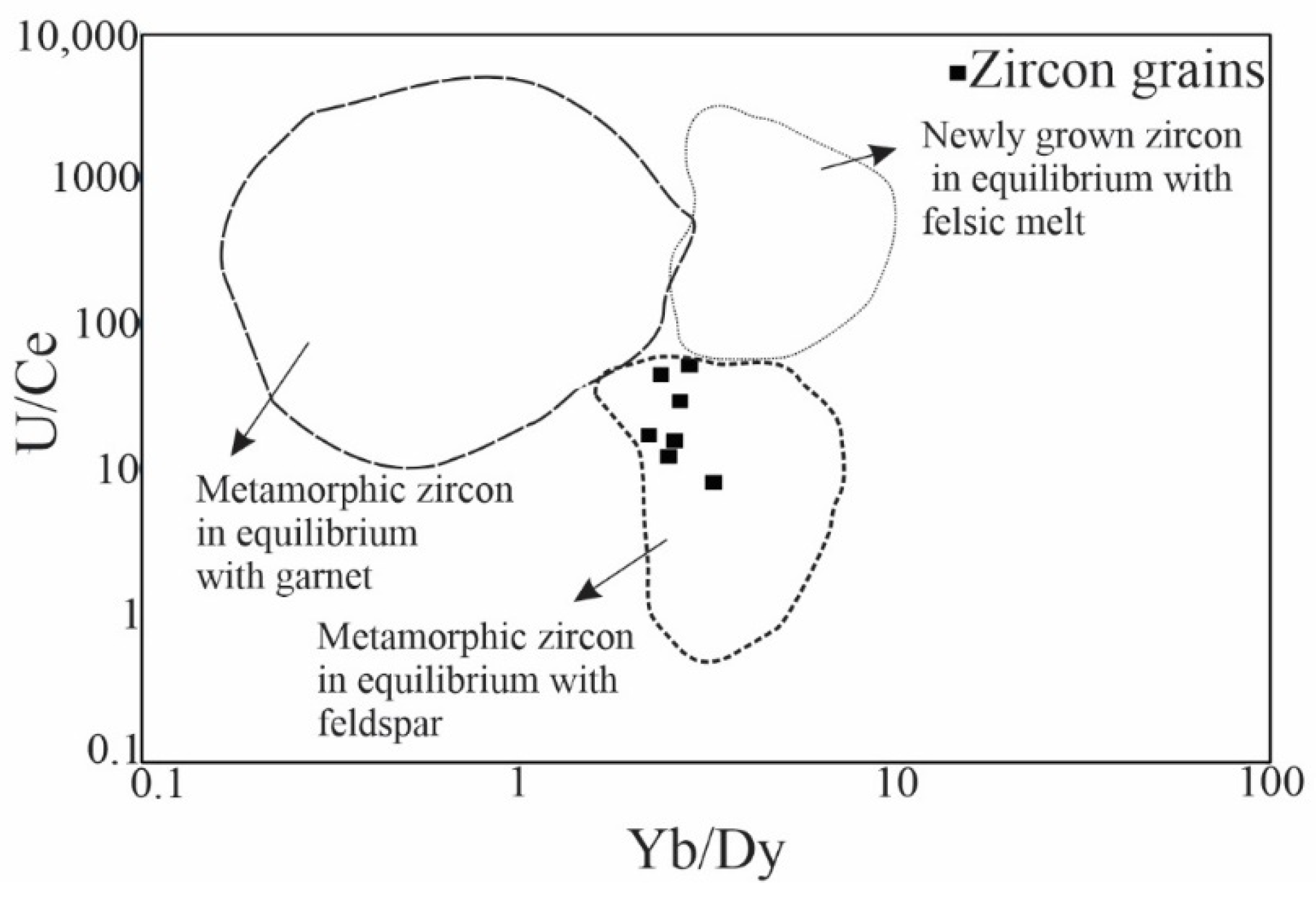
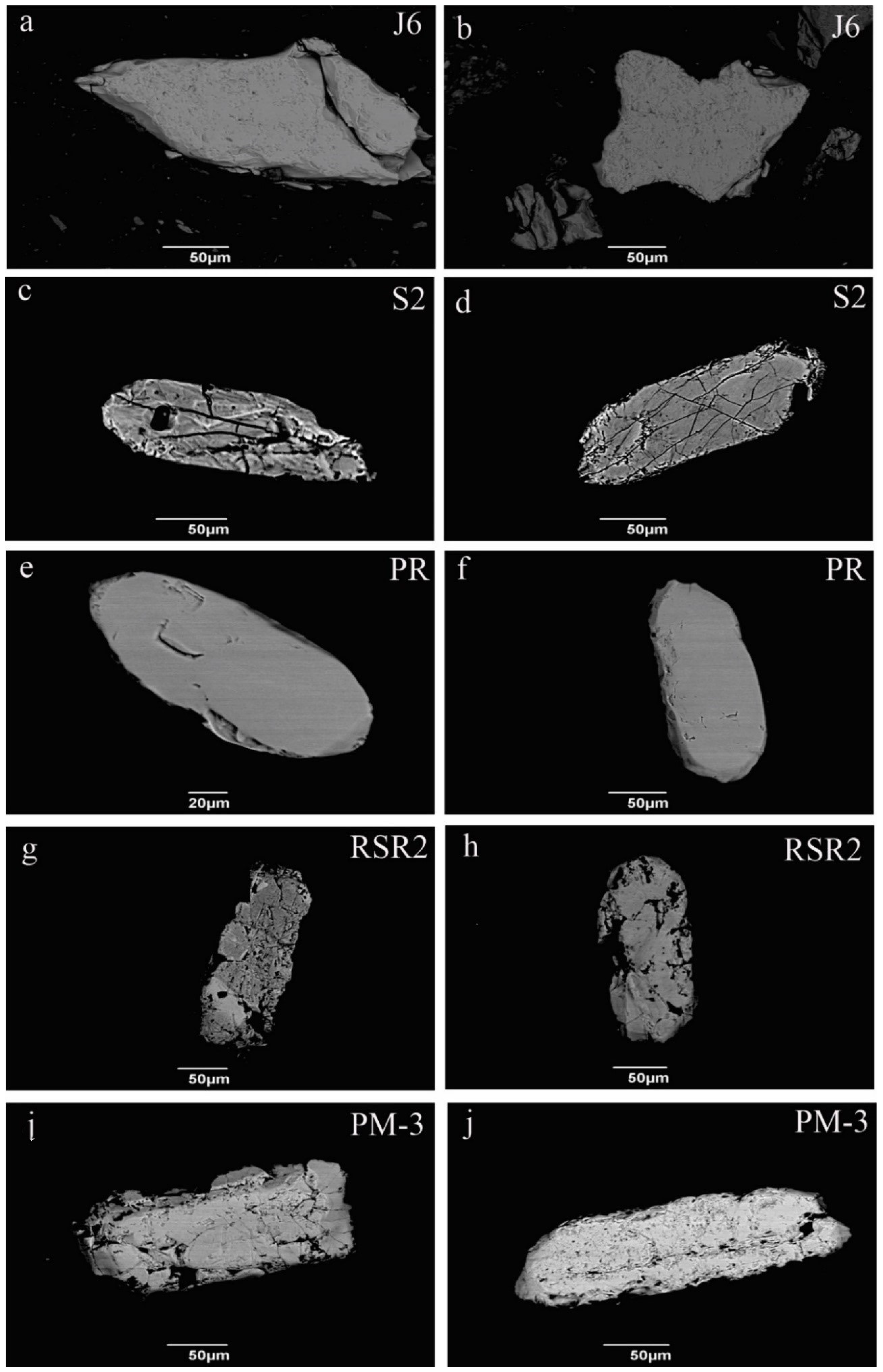
| PR (Paradeep Beach) | S2 (Siali Beach) | J3 (Jahanaia Beach) | J6 (Mahanadi River) | RSN10 (North of Rushikulya River) | PM-3 (Podampata) | RSR2 (Rushikulya River) | |
|---|---|---|---|---|---|---|---|
| P | 225.55 | 352.20 | 424.76 | 274.79 | 353.10 | 725.85 | 828.45 |
| Ca | <LOD | 390.49 | <LOD | 412.46 | <LOD | 405.64 | 453.08 |
| Ti | 11.24 | 12.22 | 18.48 | 15.59 | 10.44 | 11.94 | 17.49 |
| Mn | 2.62 | 19.39 | 10.93 | 101.10 | 3.73 | 15.52 | 11.27 |
| Fe | 208.26 | 291.80 | 693.59 | 1141.14 | 466.17 | 636.48 | 2336.75 |
| Ga | <LOD | <LOD | <LOD | <LOD | <LOD | <LOD | 2.65 |
| Rb | <LOD | 0.49 | 0.38 | <LOD | 0.27 | 0.67 | 0.47 |
| Sr | 0.35 | 0.71 | 0.62 | 2.96 | 0.58 | 0.89 | 0.75 |
| Y | 882 | 750 | 1413 | 852 | 879 | 1443 | 1230 |
| Nb | 4.50 | 2.60 | 6.07 | 4.74 | 2.65 | 5.71 | 8 |
| Ba | 0.62 | 0.97 | 0.8 | 1.30 | 0.57 | 0.90 | 2.64 |
| La | 0.55 | 1.51 | 2.60 | 4.49 | 0.93 | 2.28 | 5.74 |
| Ce | 11.13 | 14.01 | 24.06 | 33.05 | 12.16 | 14.80 | 32 |
| Pr | 0.67 | 1.39 | 1.47 | 3 | 0.92 | 1.40 | 5.84 |
| Nd | 3.54 | 8.57 | 10.55 | 16.47 | 5.79 | 9.44 | 30.2 |
| Sm | 4.76 | 8.57 | 11.34 | 10.02 | 5.51 | 9.03 | 18.47 |
| Eu | 0.55 | 1.38 | 1.67 | 1.85 | 1.27 | 1.45 | 4.27 |
| Gd | 23.60 | 29.39 | 41.63 | 26.23 | 19.98 | 35.34 | 39.03 |
| Tb | 6.78 | 8.09 | 11.57 | 7.02 | 6.80 | 12.34 | 12.54 |
| Dy | 83.28 | 81.75 | 138.02 | 81.74 | 80.89 | 146.04 | 139.24 |
| Ho | 29.02 | 25.24 | 49.49 | 29 | 28.30 | 50.36 | 44.52 |
| Er | 93.15 | 108.49 | 223.28 | 132.07 | 130.74 | 223.42 | 190.85 |
| Tm | 20.30 | 20.35 | 40.89 | 25.35 | 26.56 | 43.02 | 38.38 |
| Yb | 200.64 | 183.00 | 360.94 | 217.53 | 231.52 | 395.01 | 351.21 |
| Lu | 43.67 | 33.92 | 70.86 | 41.59 | 43.00 | 69.84 | 62.33 |
| Hf | 10,052 | 12,239 | 10,467 | 9554 | 12,013 | 12,171 | 12,393 |
| Ta | 2.23 | 1.15 | 2.29 | 1.81 | 1.72 | 3.43 | 5.87 |
| Pb | 23.38 | 20.66 | 47.83 | 28.63 | 27.02 | 29.69 | 20.68 |
| Th | 133.78 | 124.72 | 438.74 | 187.67 | 248.41 | 194.80 | 209.46 |
| U | 510.86 | 247.84 | 487.92 | 275.04 | 644.87 | 447.20 | 401.66 |
| U/Yb | 2.68 | 2.49 | 1.14 | 1.26 | 2.81 | 1.23 | 0.94 |
| Th/U | 0.26 | 0.50 | 1.13 | 0.68 | 0.38 | 0.43 | 0.52 |
| U/Ce | 45.89 | 17.69 | 16.12 | 8.32 | 53.03 | 30.21 | 12.55 |
| Y/Yb | 4.39 | 4.09 | 3.91 | 3.91 | 3.79 | 3.65 | 3.50 |
| Yb/Dy | 2.40 | 2.23 | 2.61 | 3.32 | 2.86 | 2.70 | 2.52 |
| Hf/Yb | 50.10 | 66.88 | 29.00 | 43.92 | 51.89 | 30.81 | 35.28 |
| East Coast of Tamilnadu, India [21] (ppm) | West Coast of South Africa [22] (ppm) | Southeast Goergia [35] | Southwestern Gulf of Mexico [36] | Our Study (Eastern Coast of India, n = 7) | |
|---|---|---|---|---|---|
| Hf | 3961 | 15,000 | 11,200 | 10,079.8 | 11,270.4 |
| Y | 32.5 | 1300 | 867 | - | 1064.5 |
| P | 3 | 1125 | - | - | 455 |
| Th | 6.5 | 150 | 112 | 74.10 | 219.6 |
| U | 1.82 | 50 | 261 | 125.58 | 416.5 |
| La | 81.06 | 52.5 | 8.8 | 1.82 | 2.6 |
| Ce | 54.38 | 87.25 | 38.4 | 24.49 | 19.5 |
| Pr | 11.5 | 4.25 | 3.05 | 0.28 | 2.2 |
| Nd | 51.81 | 26.25 | 12.7 | 1.99 | 12.3 |
| Sm | 9.78 | 13.75 | 6.2 | 2.06 | 9.4 |
| Eu | 1.08 | 4.25 | 1.13 | 0.52 | 1.8 |
| Gd | 8.21 | 60.75 | 19.9 | 10.17 | 28.9 |
| Dy | 7.1 | 192 | 70.7 | 44.30 | 102.2 |
| Er | 5.44 | 253.5 | 116 | 83.03 | 146.4 |
| Yb | 8.78 | 310 | 229 | 184.47 | 263.2 |
| Lu | 0.91 | - | 49.5 | 41.04 | 49.1 |
Disclaimer/Publisher’s Note: The statements, opinions and data contained in all publications are solely those of the individual author(s) and contributor(s) and not of MDPI and/or the editor(s). MDPI and/or the editor(s) disclaim responsibility for any injury to people or property resulting from any ideas, methods, instructions or products referred to in the content. |
© 2023 by the authors. Licensee MDPI, Basel, Switzerland. This article is an open access article distributed under the terms and conditions of the Creative Commons Attribution (CC BY) license (https://creativecommons.org/licenses/by/4.0/).
Share and Cite
Mohanty, S.; Papadopoulos, A.; Petrelli, M.; Papadopoulou, L.; Sengupta, D. Geochemical Studies of Detrital Zircon Grains from the River Banks and Beach Placers of Coastal Odisha, India. Minerals 2023, 13, 192. https://doi.org/10.3390/min13020192
Mohanty S, Papadopoulos A, Petrelli M, Papadopoulou L, Sengupta D. Geochemical Studies of Detrital Zircon Grains from the River Banks and Beach Placers of Coastal Odisha, India. Minerals. 2023; 13(2):192. https://doi.org/10.3390/min13020192
Chicago/Turabian StyleMohanty, Samikshya, Argyrios Papadopoulos, Maurizio Petrelli, Lambrini Papadopoulou, and Debashish Sengupta. 2023. "Geochemical Studies of Detrital Zircon Grains from the River Banks and Beach Placers of Coastal Odisha, India" Minerals 13, no. 2: 192. https://doi.org/10.3390/min13020192
APA StyleMohanty, S., Papadopoulos, A., Petrelli, M., Papadopoulou, L., & Sengupta, D. (2023). Geochemical Studies of Detrital Zircon Grains from the River Banks and Beach Placers of Coastal Odisha, India. Minerals, 13(2), 192. https://doi.org/10.3390/min13020192







